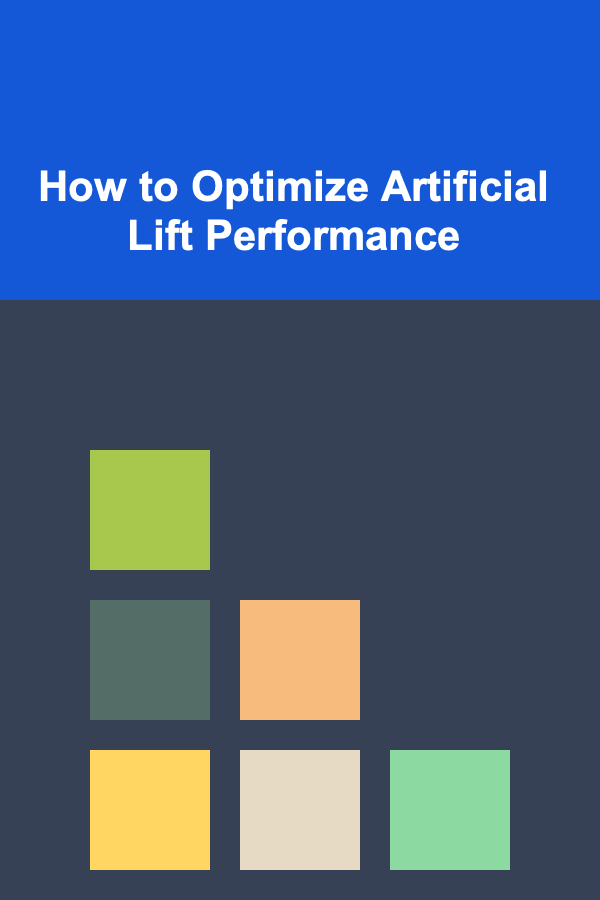
How to Optimize Artificial Lift Performance
ebook include PDF & Audio bundle (Micro Guide)
$12.99$7.99
Limited Time Offer! Order within the next:

Artificial lift is a critical component in the oil and gas industry, enabling the extraction of hydrocarbons from wells that no longer flow naturally due to declining reservoir pressure. Over time, maintaining the performance of artificial lift systems can become challenging. As a result, optimizing these systems is essential to ensure efficient, cost-effective production while minimizing downtime and maintenance. This article will explore the factors affecting artificial lift performance, techniques for optimization, and best practices for enhancing the longevity and efficiency of artificial lift systems.
Introduction to Artificial Lift Systems
Artificial lift encompasses various techniques and devices designed to increase the flow of oil and gas from a well. These systems are used when natural reservoir pressure is insufficient to push hydrocarbons to the surface. The most common types of artificial lift methods include:
- Rod Pumps (Beam Pumps): These are mechanical devices powered by an electric motor or engine that drives a pump inside the wellbore.
- Electric Submersible Pumps (ESPs): These pumps are submerged in the well and powered by an electric motor, ideal for wells with high flow rates and deeper depths.
- Gas Lift: This method involves injecting gas into the well to reduce the hydrostatic pressure and enhance the flow of oil or gas.
- Hydraulic Lift: A hydraulic fluid is used to lift hydrocarbons to the surface, often in offshore and deepwater applications.
- Progressive Cavity Pumps (PCPs): These are specialized pumps used in high-viscosity wells, where other methods may be less efficient.
Each method has its strengths and weaknesses, and selecting the right one depends on the well's depth, production rate, fluid properties, and operating conditions. However, regardless of the type of artificial lift system, optimizing performance is key to maximizing efficiency and extending the system's operational life.
Understanding the Key Factors That Affect Artificial Lift Performance
Optimizing artificial lift performance begins with understanding the primary factors that influence its effectiveness. These factors include:
2.1 Reservoir Characteristics
The properties of the reservoir, such as pressure, temperature, and fluid composition, can impact the type of artificial lift system that is most appropriate. For example:
- Pressure Decline: As the reservoir pressure decreases over time, the efficiency of natural flow diminishes, necessitating the use of artificial lift. Properly matching the artificial lift system to the reservoir's evolving characteristics can significantly improve efficiency.
- Fluid Properties: The type of fluid being produced (light oil, heavy oil, gas, or water) will affect the choice of lift method. Heavy oil, for instance, may require progressive cavity pumps, while lighter fluids may benefit from gas lift or electric submersible pumps.
2.2 Wellbore Conditions
The condition of the wellbore itself plays a critical role in the performance of artificial lift systems. Factors to consider include:
- Wellbore Geometry: A well with an irregular shape or obstructed flow paths can hinder the lift process, requiring specialized techniques.
- Corrosion and Scaling: Over time, wellbore materials can corrode or accumulate scale, obstructing the flow and reducing efficiency. Regular maintenance and monitoring can prevent such issues from affecting artificial lift performance.
2.3 Pumping Equipment
The type and condition of the pumping equipment are vital for optimizing lift performance. For example:
- Pump Size and Type: The selection of pump size and type must be tailored to the specific well's production characteristics. Over-sized or under-sized pumps can result in poor performance, increased wear, and higher energy consumption.
- Pump Efficiency: Regular maintenance and monitoring of pump efficiency can prevent performance degradation over time. Factors such as motor load, impeller wear, and power consumption should be assessed periodically.
2.4 Surface Equipment
Surface equipment, such as separators, compressors, and power supply systems, also affects the overall performance of artificial lift systems. Effective integration and coordination between the surface equipment and the downhole pump are essential for optimizing production and minimizing downtime.
2.5 Energy Consumption
Artificial lift systems, particularly ESPs and rod pumps, can be energy-intensive. Optimizing energy usage is critical for reducing operating costs and ensuring long-term economic viability. Balancing the need for lifting efficiency with energy consumption is a key consideration when designing and operating an artificial lift system.
Strategies for Optimizing Artificial Lift Performance
Now that we have established the factors that affect artificial lift performance, let's delve into the strategies for optimizing these systems. Optimization involves both preventive measures to extend the life of the equipment and real-time adjustments to maximize the output.
3.1 Accurate Well Monitoring and Data Collection
Optimization begins with accurate and continuous monitoring of well performance. By installing sensors downhole and on the surface, operators can collect data on a range of variables such as:
- Flow Rate: Monitoring the production rate can help identify when a well is underperforming or when production rates are declining.
- Pump Performance: Sensors can measure parameters like pump speed, motor load, and voltage to assess pump performance.
- Pressure and Temperature: These measurements help in understanding the dynamic behavior of the well, assisting in making real-time adjustments to optimize lift.
By analyzing the data, operators can make informed decisions regarding adjustments to the lift system. For example, if pressure or temperature is too high, adjustments to pump speed or gas injection rates can be made to optimize performance.
3.2 Regular Maintenance and Inspection
Routine maintenance is essential for preventing breakdowns and ensuring that artificial lift systems operate at peak efficiency. Key maintenance practices include:
- Pump Inspections: Regularly inspect the pumps for signs of wear and tear, such as broken seals, damaged impellers, or electrical malfunctions.
- Wellbore Inspection: Conducting regular wellbore surveys can help identify any damage or blockages that could affect production.
- Corrosion and Scaling: Use inhibitors and other treatments to prevent corrosion and scaling within the wellbore and pumping equipment.
In addition to routine inspections, operators should also schedule downtime for cleaning and overhauling equipment to address minor issues before they become major problems.
3.3 Optimize Pumping Parameters
To achieve the best artificial lift performance, operators should continually optimize key pumping parameters. Some of the most common parameters to adjust include:
- Pump Speed: Adjusting the speed of the pump can help achieve optimal flow rates while reducing the risk of equipment failure.
- Gas Injection Rate (for Gas Lift Systems): The rate at which gas is injected into the well must be carefully controlled to maintain the optimal pressure gradient. Too much gas will reduce the lift efficiency, while too little can result in inadequate flow.
- Pump Stroke Length (for Rod Pumps): Adjusting the stroke length on rod pumps can affect the displacement and efficiency of the system. Longer strokes tend to provide more lifting power, but too long of a stroke can cause excessive wear on the equipment.
Optimizing these parameters involves both testing different configurations and using data to continuously adjust and fine-tune performance.
3.4 Use of Advanced Technologies and Automation
The rise of automation and advanced technologies has greatly enhanced the ability to optimize artificial lift performance. Technologies such as:
- Automated Control Systems: These systems can automatically adjust parameters like pump speed, gas injection rates, and pressure, allowing for real-time optimization without manual intervention.
- Data Analytics: Advanced algorithms can analyze large datasets from sensors and control systems to detect inefficiencies, predict failures, and suggest corrective actions.
- Machine Learning: Machine learning models can predict future well performance based on historical data, helping operators anticipate issues before they arise and make proactive adjustments.
Integrating these technologies into artificial lift operations can significantly improve performance, reduce costs, and extend the life of the system.
3.5 Use of Enhanced Oil Recovery (EOR) Techniques
In many mature wells, artificial lift can be optimized by combining it with enhanced oil recovery (EOR) techniques. These methods, such as water flooding, gas injection, and chemical flooding, can help maintain reservoir pressure and improve the overall efficiency of artificial lift systems.
By introducing a secondary source of pressure into the well, EOR techniques can provide a significant boost to artificial lift performance, allowing operators to maintain higher production rates and extend the life of the well.
Key Challenges and Solutions in Artificial Lift Optimization
While optimizing artificial lift performance is crucial for maximizing production, it comes with several challenges. Some of the most common challenges include:
4.1 High Energy Costs
Artificial lift systems can consume a large amount of energy, especially for deep wells. Operators must balance energy consumption with production rates to ensure that the process remains cost-effective.
Solution: Implementing energy-efficient pumps and motors, optimizing pump speed, and exploring alternative energy sources (such as solar power for surface equipment) can help reduce energy costs.
4.2 Equipment Failure and Downtime
Frequent equipment failures and unplanned downtime can significantly reduce production rates and increase maintenance costs.
Solution: Proactive maintenance, real-time monitoring, and the use of automated control systems to detect early signs of equipment failure can help minimize downtime and improve system reliability.
4.3 Reservoir Management
As reservoirs mature, their pressure and flow characteristics change, requiring operators to adjust their artificial lift systems accordingly.
Solution: Continuous monitoring, reservoir simulation models, and timely adjustments to artificial lift parameters (such as gas injection rates or pump speed) can help maintain optimal performance as reservoir conditions change.
Conclusion
Optimizing artificial lift performance is an ongoing process that requires a combination of good practices, technology, and proactive management. By monitoring well conditions, performing regular maintenance, adjusting pumping parameters, and leveraging advanced technologies, operators can ensure that their artificial lift systems operate at maximum efficiency and contribute to the long-term success of oil and gas production.
Reading More From Our Other Websites
- [Home Space Saving 101] How to Tidy Your Home and Save Space with Minimalist Decor
- [Organization Tip 101] Lighting Tips to Enhance the Boho Vibe in Your Bedroom
- [Home Staging 101] How to Stage a Small Apartment for Maximum Impact
- [Home Security 101] How to Ensure Home Security When You Live Alone
- [Home Staging 101] How to Stage a Home with Kids and Pets for a Successful Sale
- [Home Renovating 101] How to Landscape Your Yard for Maximum Curb Appeal
- [Organization Tip 101] How to Organize Birthday and Holiday Gift Lists
- [Home Staging 101] How to Stage Your Home for a Quick Sale
- [Sewing Tip 101] Must-Know Sewing Hacks Every Beginner Should Master
- [Personal Care Tips 101] How to Use Toothpaste to Keep Your Mouth Feeling Fresh After Meals

How to Organize Your Technology: Gadgets, Cords, and Accessories
Read More
How to Set Up SMS Automation for Abandoned Cart Recovery in Your Dropshipping Store
Read More
How to Use Spreadsheets to Track Important Information
Read More
How to Plan a Successful Snowboard Instructor Season
Read More
How to Organize Your Literary Agent Research with a Planner
Read More
10 Tips for Staying Ahead of Digital Marketing Trends
Read MoreOther Products

How to Organize Your Technology: Gadgets, Cords, and Accessories
Read More
How to Set Up SMS Automation for Abandoned Cart Recovery in Your Dropshipping Store
Read More
How to Use Spreadsheets to Track Important Information
Read More
How to Plan a Successful Snowboard Instructor Season
Read More
How to Organize Your Literary Agent Research with a Planner
Read More